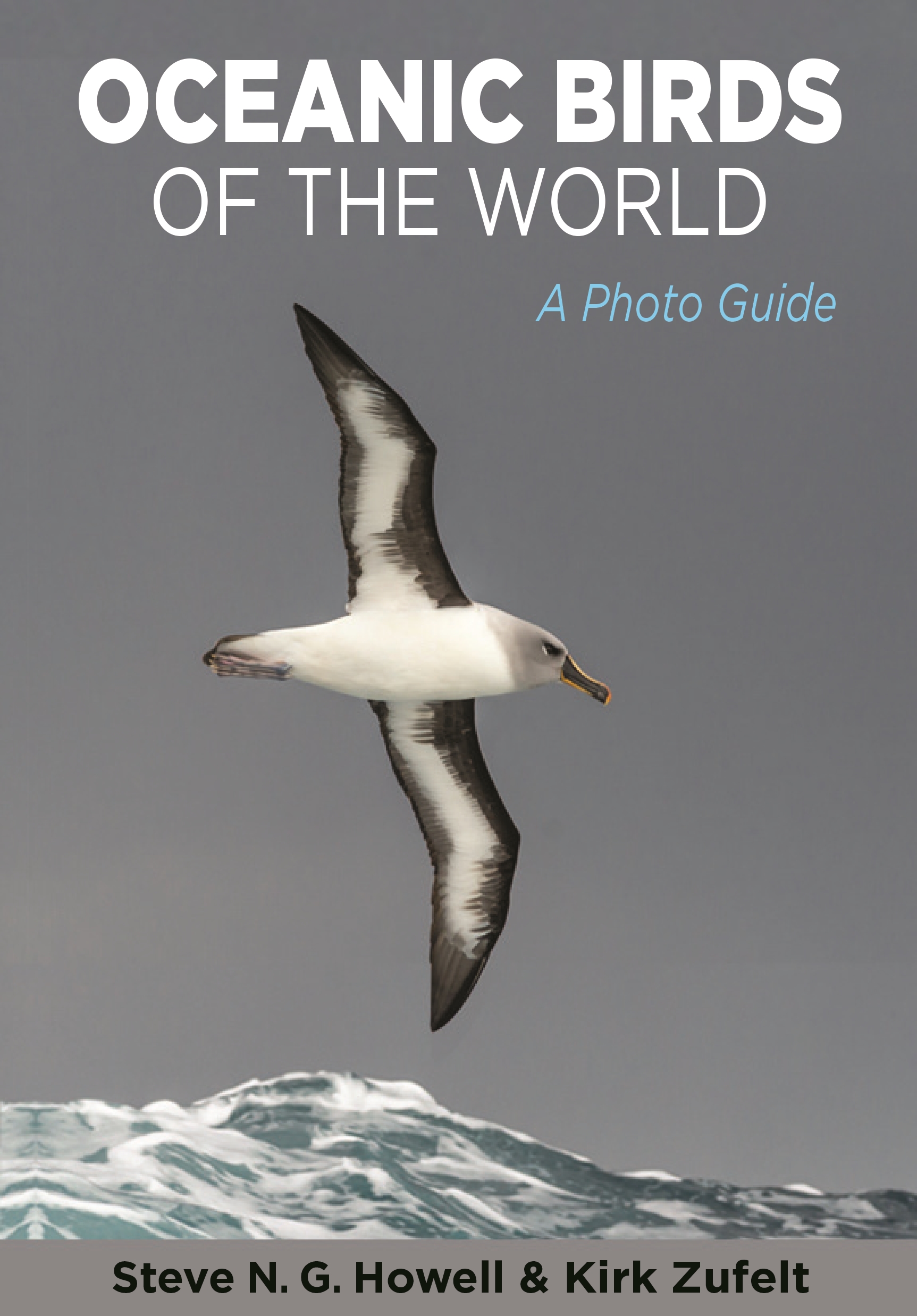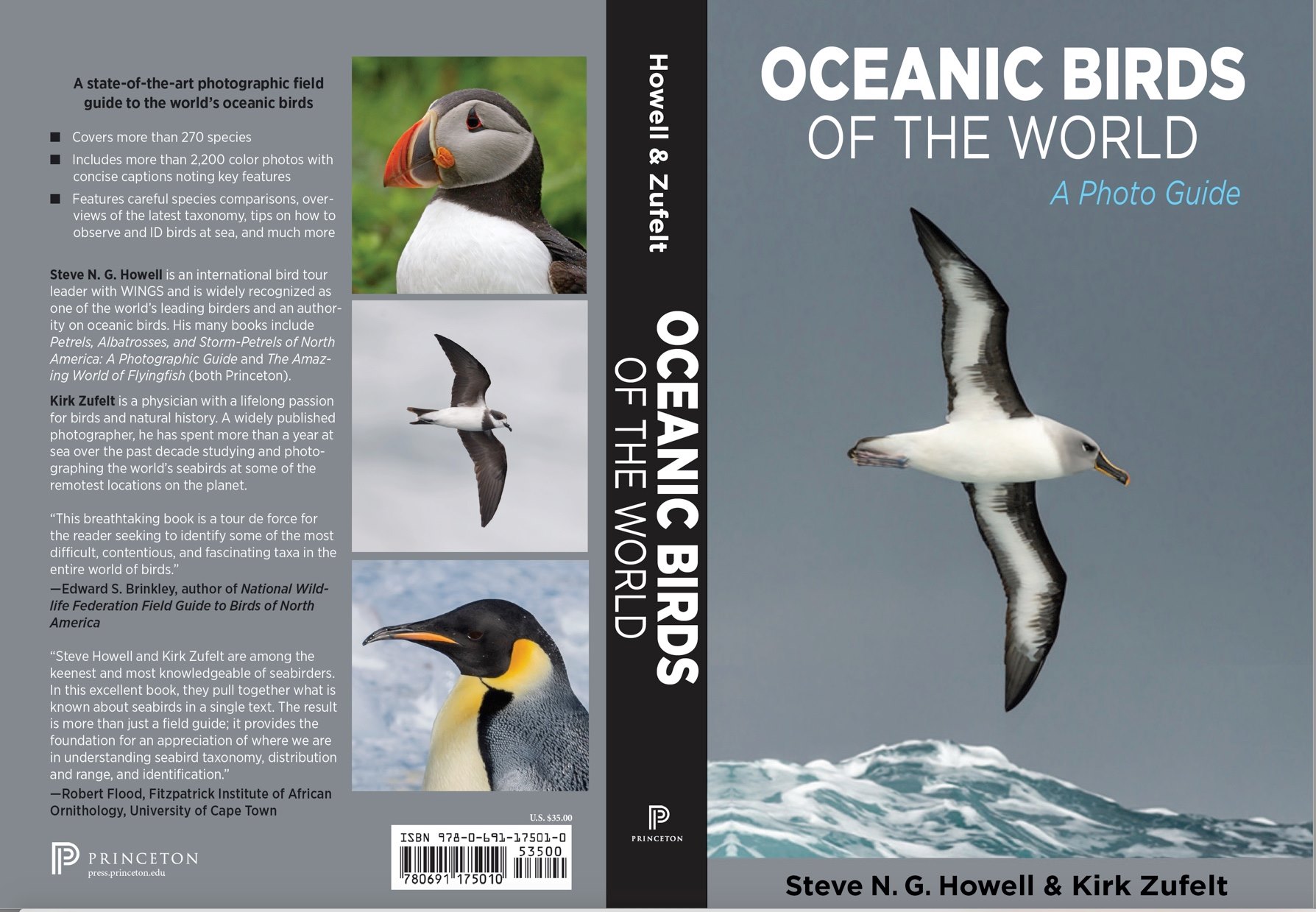
Introduction
Those who watched seabirds at sea and from the shore back in the 1980s and 1990s (like I did) would have used one or both of Peter Harrison’s two seabird books; the iconic guide of 1983, and the photo guide that followed it in 1987, to help them with their IDs. Quite a lot has changed with seabirds and their study since then, for just one example think digital cameras with stabilized lenses that allow such crisp photographs that they can be used to score wing moult in birds flying alongside a ship at sea. There have also been significant changes in the classification of birds with a tendency of late to give specific status to more populations; so more species are now out there to photograph and describe in their various age classes. Time then for new guides for the seabirder’s shelf and backpack.
For photo guides the gap has been nicely filled with last year’s publication by Steve Howell and Kirk Zufelt of Oceanic Birds of the World: a Photo Guide. Before getting too far into a review, let’s see what the authors consider is an “oceanic bird” - and what are not. The true “pelagics” are all included, the whole tubenose order Procellariiformes (albatrosses, petrels and their kin), as are all the penguins, with 19 species recognized. Among the Pelecaniformes in go the frigate birds, tropic birds and sulids (gannets and boobies) but no marine cormorants or pelicans get a look in. Farther along in the book we can find the skuas (jaegers) and alcids (auks and allies), but only 19 species of gulls, terns and noddies among the 50+ larids in the world, the majority of which are marine birds. Surprisingly to me, both Arctic and Antarctic Terns, which migrate across vast swathes of open ocean far from land, are not included. Here’s the rub then, that every author of a seabird book has come up against: define by taxonomy or habitat? Every seabird book I know has got into a muddle over this, mixing both approaches, including the book under review, leading to some oddities. For example the African and Galapagos Penguins occur closer to the land than do the missing terns mentioned above when migrating, and do not really go farther offshore than the equally missing marine cormorants and pelicans One way out of this conundrum might have been to have a photo guide purely for the tubenoses. However, it is only fair to say that the authors address the thorny issue in their preface, admitting the “inevitably subjective nature” of choosing which species to include.
Albatrosses and Petrels
A total of 213 pages of the 358-page book is devoted to the albatross and petrel order; the rest of the “more than 270” seabirds covered get only 82 pages in the main species accounts section. The tubenoses need all this space as there are a lot more albatrosses and petrels to depict and describe than Peter Harrison had. This has come about by ‘splitting’ (now 22 albatross species in four genera, as opposed to 13 and only two back in the 1980s), but also by new discoveries (for example Bryan’s Shearwater Puffinus bryani first described in 2011). Howell and Zufelt are nothing but up to date with their new species. In fact, an intriguing four-page section towards the back of the book is entitled “Recently described and provisionally split species” where you will find a bunch of new tubenoses, some not yet formally described, with suggested names; “Darwin’s Storm-petrel” being just one example. The authors consider themselves birders “free from the bureaucratic molasses that taxonomists have created for themselves” who can “catch up later”!
For each bird in the main text you will find LOTs of photos (the book’s back-cover ‘blurb’ says over 2200). I counted no less than 36 (may well have missed some) for the Wandering Albatross Diomedea exulans (called ‘Snowy Wandering’ by the authors). In contrast the Harrison photo guide has only two! Nearly all of these 36 Wanderer photos depict birds in flight, a feature throughout the book. Even Bryan’s Shearwater gets three photos – and one imagines there would be more if the authors get a chance to photograph it themselves. Along with the plethora of photos comes the usual field guide information on identification, especially in flight with attention to age classes and gender differences where such apply. You also get information on size, distribution (with maps) and on moult.

Some Thoughts
Field guides are taken into the field, in this case to sea. They need to survive rough treatment, including getting wet. Howell and Zufelt’s Oceanic Birds is a soft cover printed on glossy paper to help with moisture from sea spray on a ‘pelagic’ trip. The sections are stitched but only time will tell how well the book stands up. As now pretty much an armchair marine ornithologist my own copy is not getting properly tested so someone younger than myself can report in a couple of years perhaps.
Overall, the book has a distinctly ‘crowded’ look with bled photos and narrow margins top and bottom – but that means you get “bang for your buck”, as the North American authors might say. There’s a lot more I’ve not mentioned to be found in Oceanic Birds. Gotta be an essential in any reasonable seabird library!
Reference:
Howell, Steve N.G & Zufelt, Kirk 2019. Oceanic Birds of the World: a Photo Guide. Princeton & Oxford: Princeton University Press. 358 pp. Over 2200 individual colour photographs arranged in 368 plates, 114 maps. ISBN 978-0-691-17501-0. Soft Cover, 15 x 21 cm, UK£30.00 / USA$35.00.

 English
English  Français
Français  Español
Español